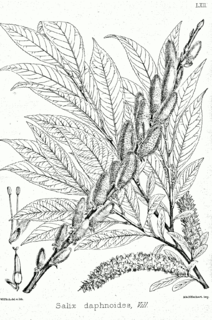This page is based on this
Wikipedia article Text is available under the
CC BY-SA 4.0 license; additional terms may apply.
Images, videos and audio are available under their respective licenses.

Willows, also called sallows and osiers, form the genus Salix, around 400 species of deciduous trees and shrubs, found primarily on moist soils in cold and temperate regions of the Northern Hemisphere. Most species are known as willow, but some narrow-leaved shrub species are called osier, and some broader-leaved species are referred to as sallow. Some willows are low-growing or creeping shrubs; for example, the dwarf willow rarely exceeds 6 cm (2.4 in) in height, though it spreads widely across the ground.

Salix alba, the white willow, is a species of willow native to Europe and western and central Asia. The name derives from the white tone to the undersides of the leaves.

Salix caprea is a common species of willow native to Europe and western and central Asia.

Salix purpurea is a species of willow native to most of Europe and western Asia north to the British Isles, Poland, and the Baltic States.

Salix fragilis, with the common names crack willow and brittle willow, is a species of willow native to Europe and Western Asia. It is native to riparian habitats, usually found growing beside rivers and streams, and in marshes and water meadow channels.

Pussy willow is a name given to many of the smaller species of the genus Salix when their furry catkins are young in early spring. These species include :

Salix discolor, the American pussy willow or glaucous willow, is a species of willow native to North America, one of two species commonly called pussy willow.

Salix viminalis, the basket willow, common osier or osier, is a species of willow native to Europe, Western Asia, and the Himalayas.
Salix babylonica is a species of willow native to dry areas of northern China, but cultivated for millennia elsewhere in Asia, being traded along the Silk Road to southwest Asia and Europe.

Salix myrtilloides, the swamp willow, is a willow native to boglands in cool temperate to subarctic regions of northeastern Europe and northern Asia from central Norway and Poland eastwards to the Pacific Ocean coasts, with isolated populations further south in mountain bogs in the Alps, Carpathians and Sikhote-Alin mountains.

Salix lucida, the shining willow, Pacific willow, or whiplash willow, is a species of willow native to northern and western North America, occurring in wetland habitats.

Salix triandra, with the common names almond willow or almond-leaved willow, is a species of willow native to Europe and Western and Central Asia. It is found from south-eastern England east to Lake Baikal, and south to Spain and the Mediterranean east to the Caucasus, and the Alborz Mountains. It usually grows in riparian habitats, on river and stream banks, and in wetlands.

Batrachedra praeangusta is a moth of the Batrachedridae family which is native to Europe. It is also found in North America. It was first described by Adrian Haworth in 1828 from the type specimen found in England. The foodplants of the larvae are poplars and willows.

Ectoedemia intimella is a moth of the Nepticulidae family which is found in Europe. It flies in June and July and the larva mine the leaves of willows from July to November.

Agonopterix conterminella is a moth of the Depressariidae family which is found in Asia, Europe and North America. It was first described by Philipp Christoph Zeller in 1839 from a specimen found in Augsburg, Germany. The larva feed on the terminal shoots of willows.

Salix eleagnos the bitter willow, olive willow, hoary willow, rosemary willow, or elaeagnus willow, is a species of flowering plant in the family Salicaceae, native to central and southern Europe and south west Asia. Growing to 3 m (10 ft) tall by 5 m (16 ft) broad, it is an erect bushy deciduous shrub with narrow grey-green leaves up to 20 cm (8 in) long, which turn yellow in autumn (fall). The green catkins, 3–6 cm (1–2 in) long, appear with the leaves in spring, male catkins having yellow anthers.

Salix daphnoides or European violet willow is a species of plant in the family Salicaceae. It can grow as a large shrub or small tree, normally reaching a height of between 6 and 8 metres, but can grow up to 12 metres tall.


















